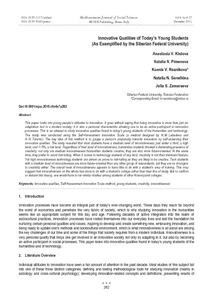Показать сокращенную информацию
Innovative qualities of today's young students (as exemplified by the Siberian Federal University)
| Автор | Kistova, A. V. | |
| Автор | Pimenova, N. N. | |
| Автор | Reznikova, K. V. | |
| Автор | Seredkina, N. N. | |
| Автор | Zamaraeva, Ju. S. | |
| Дата внесения | 2016-11-11T08:49:21Z | |
| Дата, когда ресурс стал доступен | 2016-11-11T08:49:21Z | |
| Дата публикации | 2015-12 | |
| Библиографическое описание | Kistova, A. V. Innovative qualities of today's young students (as exemplified by the Siberian Federal University) [Текст] / A. V. Kistova, N. N. Pimenova, K. V. Reznikova, N. N. Seredkina, Ju. S. Zamaraeva // Mediterranean Journal of Social Sciences. — 2015. — 6 S7 (№ 6). — С. 262-268 | |
| URI (для ссылок/цитирований) | https://elib.sfu-kras.ru/handle/2311/27851 | |
| Аннотация | This paper looks into young people’s attitudes to innovation. It goes without saying that being innovative is more than just an adaptation tool in a modern society; it is also a personal characteristic allowing one to be an active participant in innovation processes. This is an attempt to study innovative qualities found in today’s young students of the humanities and technology. The study was conducted using the Self-Assessment Innovation Scale (a method designed by N. M. Lebedeva and A. N. Tatarko). The key idea of this method is to gauge a person’s propensity towards innovation by self-assessing their innovative qualities. The study revealed that most students have a medium level of innovativeness; just under a third, a high level; and 1–5%, a low level. Regardless of their level of innovativeness, humanities students showed a dominating presence of creativity: not only are medium innovativeness humanities students creative, they are also more future-oriented. At the same time, they prefer to avoid risk-taking. When it comes to technology students of any kind, creativity is not their dominant feature. Yet high innovativeness technology students are almost as prone to risk-taking as they are likely to be creative. Tech students with a medium level of innovativeness are more future-oriented than any other group of respondents, but they are no strangers to creativity either. The overall level of innovativeness appears to have little to do with a student’s area of training. This may suggest that innovativeness on the whole has more to do with a student’s college rather than their line of study. But to confirm or debunk this theory, one would have to run similar studies among students of other Krasnoyarsk colleges. | |
| Ссылка на другой сайт | http://www.mcser.org/journal/index.php/mjss/article/view/8628 | |
| Тема | Innovative qualities | |
| Тема | Self-Assessment Innovation Scale method | |
| Тема | young students | |
| Тема | creativity | |
| Тема | innovativeness | |
| Название | Innovative qualities of today's young students (as exemplified by the Siberian Federal University) | |
| Тип | Journal Article | |
| Тип | Published Journal Article | |
| Страницы | 262-268 | |
| ГРНТИ | 13.07.27 | |
| Дата обновления | 2016-11-11T08:49:21Z | |
| Институт | Гуманитарный институт | |
| Подразделение | Кафедра культурологии | |
| Журнал | Mediterranean Journal of Social Sciences | |
| Квартиль журнала в Scopus | Q3 |

